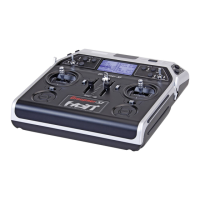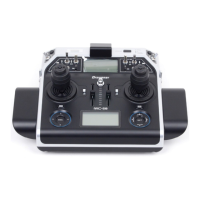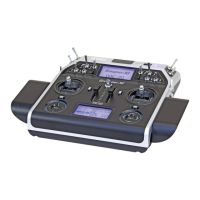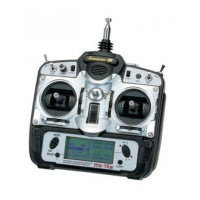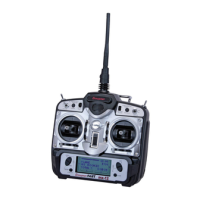326
Programming examples - Helicopter models
If you switch from this graphic to the autorotation
phase for testing purposes, the following appears
instead of the accustomed representation:
OFF
C1 Thro
Autorot
That means that this mixer is switched off and the
throttle servo is switched to a fixed value, which can be
adjusted as follows:
Return to the menu list with a tap on the ESC key. As
long as you are still in the autorotation phase, new sub-
menus are listed; specifically:
Pitch
0%
Autorot
–100%
0%
Gyro gain 0%
Thr setting AR
Tailoffset AR
Gyro suppress
The line “Thr. setting AR” is important. Enter the value
to the right, depending on servo direction, to either ap-
proximately +125 % or -125 %.
0%
Autorot
0%
0%
–125%
SEL
Pitch
Gyro gain
Thr setting AR
Tailoffset AR
Gyro suppress
In doing so, the motor is safely switched off in the auto-
rotation phase (in case of emergency). Later, when you
have gained enough experience to practice the autoro-
tation flight, a more stable idle can be entered here.
Adjustment notice for electric helicopters:
Since the motor must also be shut off for
electrically powered helicopters in case of an
emergency, this setting is to adopted without
change.
The further sub-menus are not important at the mo-
ment. By switching off “autorotation”, it returns to the
first menu list.
Select the “C1 Tail” settings page in order to set
static torque compensation for the tail rotor. In this
case, also work with a maximum of three interpolation
points; everything else is reserved for the experienced
pilot. Do this by changing the heading-lock systems
from their intended uniform pre-setting of 0 % at point
“L” (minimum pitch) to -30 % and at the opposite end,
at point “H” to +30 % (maximum pitch). These values
may have to be corrected in flight. It may also be nec-
essary to set point “1” in the middle.
0%
0%
0%
Tail
C1
Input
Output
Point
Normal
Curve
off
?
Now, for testing purposes, switch back to the autorota-
tion phase. Here the setting is also deactivated; the tail
servo no longer reacts to pitch movements (no torque
usually arises when the main rotor is not powered).
All additional interpolation points are not currently of
importance yet. Navigate by pressing the central ESC
button of the left-hand four-way button one level up:
0%
Autorot
0%
0%
–125%
SEL
Pitch
Gyro gain
Thr setting AR
Tailoffset AR
Gyro suppress
Set the helicopter horizontally on with the engine off.
With activated transmitting and receiving system, fold
the tail rotor blades down and change the line “Tail
rotor AR” by pressing the central SET key of the right
four-way button to activate the value field, until the
value of the tail rotor blades angle is zero degrees. The
tail rotor blades are then viewed from behind parallel.
Depending on the friction and running resistance of
the gearbox, it may be that the fuselage still rotates
slightly. This relatively weak torque must be corrected
on the tail rotor blade pitch then optionally. In any case,
this value is between zero degrees and a pitch angle
opposed to the direction of tail rotor pitch required for
normal flight.
All other sub-items are not currently important. There-
fore switch back to the normal phase.
If, contrary to the default setting, the gyro has a trans-
mitter-side sensitivity setting, another free proportional
control will be needed.
This can be assigned in the …
»Control adjust« (beginning on page 116)
… menu to “Gyro” input. Activate the control assign-
ment with a brief tap on the centre SET key of the
right touch pad then move the selected control until its
control number appears in the display:

